Nider, Johannes (Dominican professor
and prior), Formicarius
(written: c. 1435) (pub.: c. 1475, ? Augsburg) - First book on witchcraft
and second book ever printed (after Spina's Fortalicium Fidei). No comments
on sabbat. 1484. Second Edition. Folio. Striking contemporary binding;
richly rubricated in red throughout the text. Unusually, this copy closes
with a thirty-leaved manuscript in red ink on the rescuing of the soul
from Satan and the techniques of exorcism with many references to the Church
Fathers.
Vineti, Jean (Inquisitor at Carcassonne), Tractus
contra Demonum Invocatores
(written: c. 1450) - First book to identify witchcraft as heresy.
Anonymous (Inquisitor in French Cavoy), Errores
Gazariorum (written: c. 1450)
- Idea of sabbat highly developed.
Harlieb, Johann (Physician to King of Bavaria)
- Buch aller verbotenen
Kunst, Unglaubens und der Zauberei
(written: c. 1456) - First work written in German.
Nider, Johannes (Dominican professor and prior),
Preceptorium
(1507). The binding is decorated with
panel features originally cut in the mid-fifteenth century.
Jacquier, Nicholas (Inquisitor in France and Bohemia),
Flagellum
Hæreticorum Fascinariorum (written:
1458) pub.: 1581) - First major definition of witchcraft as new heresy.
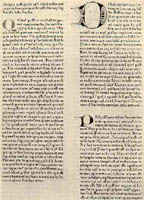 Alphonsus
de Spina (Franciscan, converted Jew),
Formicarius
Fidei (written: 1458) (pub.:
1467, Strasbourg) - First book ever printed about witchcraft.
Alphonsus
de Spina (Franciscan, converted Jew),
Formicarius
Fidei (written: 1458) (pub.:
1467, Strasbourg) - First book ever printed about witchcraft.
Anonymous (Inquisitor at Lyons), La
Vauderye de Lyonois (written:
1460) - First work written in French.
Visconti, Girolamo (Inquisitor, professor, provincial
of Lombardy), Lamiarum
sive Striarum Opusculum (written:
1460) (pub.: 1490, Milan) - Even defending witches is heresy.
Martin de Arles (Frenchman, professor and canon
in Spain), Tractatus de
Superstitionibus (written:
c. 1460) pub.: 1517, Paris)
Momor, Petrus (Canon, regent of University of
Poitiers), Flagellum Maleficorum
(written:
c. 1462) (pub.: 1490, Lyons) - Spread of witchcraft in France due to Hundred
Years' War and magic introduced by foreigners. Sabbat described.
Vignati, Ambrogio de (Jurist and professor at
Padua, Bologna, Turin), Tractatus
de Hæreticis (lectures)
(written: c. 1468) (pub.: 1581) - Urges caution with accusations by accomplices.
Jordanes de Bergamo (Master of theology at Cortona,
Italy), Quæstio
de Strigis (written: c. 1470)
- Accepts witchcraft as heresy, but tries to reconcile Canon Episcopi.
Vincent, Jean (Prior at Vendée, France)
Liber
Adversus Magicas Artes (written:
c. 1475) - Accepts magic; rejects witchcraft.
Innocent VIII (Pope), Bull;
"Summis
desiderantes affectibus" (1484,
Rome, printed in Malleus) - Appointed Sprenger and Kramer as inquisitors
to intensify witchcraft trials, using torture.
Sprenger, Jacob & Kramer, Heinrich (Inquisitors),
Malleus
Maleficarum (c. 1486) - The
most evil book of the witchcraft delusion. Developed theory of the heresy
of witchcraft into rigid code and set pattern for 300 years. 1486,
First Edition, Folio. This copy printed by Peter Drach is particularly
striking for its heavy annotations throughout in a near contemporary hand,
commencing with a poem to Satan and some descriptions of poisoning witches.
It is conjectured that a more than enthusiastic judge used this copy. There
are at least 9 or 10 other copies of the Malleus in this collection dating
from 15th - 17th centuries.
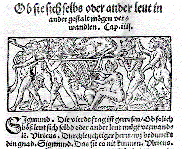 Molitor,
Ulrich (Professor of Law University of Constance), Tractatus
de Pythonicis Mulieribus (1489,
? Constance) - If witchcraft is illusion, should be punished as if real.
Molitor,
Ulrich (Professor of Law University of Constance), Tractatus
de Pythonicis Mulieribus (1489,
? Constance) - If witchcraft is illusion, should be punished as if real.
Molitor, Ulrich (Professor of Law University of
Constance), De Lamiis
(1489. This is the most important and only illustrated incunable book on
witchcraft, characterised by unusual woodcuts. Interestingly this nineteenth
century binding features the same panel decoration as the previous book.
Champier, Symphorien (Physician), Dialogus
in Magicarum Artium Destructionem
(c. 1500, Lyons) - Sabbat a delusion; maleficia due to natural causes.
Physicians should treat deluded. Remarkable enlightenment.
Prierias, Sylvester (Inquisitor in Lombardy; papal
spokesperson against Luther), Sylvestrina
Summa (1504, Bologna) - Influenced
by Malleus. Devoted to explaining away Canon Episcopi.
Prierias, Sylvester (Inquisitor in Lombardy; papal
spokesperson against Luther), De
Strigimagarum Dæmonumque Mirandis
(1521, Rome) - Accepts full-blown theory of witchcraft; gives rules for
trials, in which condemnation is inevitable.
Cassini, Samuel de (Franciscan who opposed Savonarola),
Question
de le Strie (1505, ?) - The
first book to attack the identification of witchcraft as heresy, calling
inquisitors the heretics.
Geiler von Kayserberg (Priest), Die
Emeis (written: 1508) (pub.:
1517, Strasbourg) - First book about witchcraft printed in German (collected
sermons). Advocates burning white witches as well.
Trithemius (Abbot), Liber
Octo Questionum (1508?, 1515,
Oppenheim) - Follows Malleus. All trouble caused by witches, who must be
burned.
Trithemius (Abbot), Antipalus
Maleficiorum (1508?, 1555,
Ingolstadt)
Bernard de Como (Inquisitor at Como), De
Strigiis [in Lucerna Inquisitorum]
(written: 1510) (pub.: 1566, Milan) - Accepts full-blown theory of sabbat
as real and corporeal.
Tengler, Ulric (Lawyer), Layerspiegel
(?1509, ?Milan) - Follows Malleus; secular courts should follow procedure
of Inquisition in witchcraft trials.
Alciatus, Andreas (Lawyer at Milan), Parergon
Juris (written: c. 1514) (pub.:
1558, Basel) - Skeptic: witches' delusions about sabbat can be cured by
herbs.
Pompanazzi, Pietro (Professor at Padua), De
Naturalium Effectuum Causis
(written: 1520) (pub.: 1556, Basel) - Inclined to skepticism; escaped punishment
by plea that as philosopher he might doubt, yet as Catholic he truly believed
everything the Church taught.
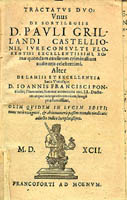 Ponzinibio,
Gianfrancesco (Lawyer at ? Florence),
Tractatus
de Lamiis (written: c. 1520)
(pub.: 1556, Basel) - Very important work, completely opposing witchcraft
delusion and conduct of trials by Inquisition. Accepts simple sorcery.
Reprinted with De sortilegiis by Paolo Grillando in 1592 (see Illustration)
Ponzinibio,
Gianfrancesco (Lawyer at ? Florence),
Tractatus
de Lamiis (written: c. 1520)
(pub.: 1556, Basel) - Very important work, completely opposing witchcraft
delusion and conduct of trials by Inquisition. Accepts simple sorcery.
Reprinted with De sortilegiis by Paolo Grillando in 1592 (see Illustration)
Pico della Mirandola, Gianfrancesco (Lawyer),
Strix
(?1523)
Pico della Mirandola, Gianfrancesco (Lawyer),
Strega(Italian)
(1524, Bologna: 1555, Pescia) - First book about witchcraft printed in
Italian. Accepts witchcraft delusion, stressing incubi.
Spina, Bartolomeo (Theologian, Master of Sacred
Palace), Quæstio
de Strigibus (written: 1523)
(pub.: 1526, Venice) - Disciple of Prierias. Most violent promulgation
of extreme witchcraft delusion to date. Opposed Ponzinibio.
Grillandus, Paulus (Papal judge in witch trials
in Rome area), Tractatus
de Hereticis et Sortilegiis
(written: 1525) (pub.: 1536, Lyons) - Major work treating in detail all
aspects of extreme witchcraft delusion from viewpoint of ecclesiastical
law.
Civelo, Pedro (Inquisitor at Saragossa), Opus
de Magica Supersitione (1521,
Alcala)
Civelo, Pedro (Inquisitor at Saragossa), Reprobación
(Spanish) - First book about witchcraft printed in Spanish, a classic for
a century; relatively moderate.
Vitoria, Francisco de (Professor of theology,
University of Salamanca), Relationes
xii Theologicae (1540) - Inclined
to skepticism.
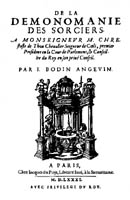 Bodin,
Jean. De la démonomanie
des sorciers [1587]. Bodin's
work Démonomanie, a study of the influence of good and evil
spirits in the world, inaccurately gave him the reputation of a witch-hunter.
Bodin,
Jean. De la démonomanie
des sorciers [1587]. Bodin's
work Démonomanie, a study of the influence of good and evil
spirits in the world, inaccurately gave him the reputation of a witch-hunter.
Grilland, Paolo: De
sortilegiis and Ponzinibio,
Gianfrancesco: Tractatus de Lamiis
Two tracts in one volume. (1592.) Tractatus
de Lamiis is a reprint of the 1520 work by Gianfrancesco Ponzinibio.
King James VI of Scotland, I of England, Daemonologie,
(1597, Edinburgh) in the form of a dialogue, divided into three books -
Book 1 - The exord of the whole. The description of Magie in special. -
Book 2 - The description of Sorcerie and Witch-craft in Speciall. - Book
3 - The description of all these kindes of Spirites that troubles men or
women. The conclusion of the whole Dialogue. Available in the
Miskatonic
University On Line Library.
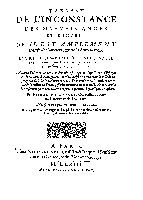 Pierre
de Lancre, Tableau de
l'inconstance des mauvais anges et démons où il est amplement
traité des sorciers et de la sorcellerie
(1612) Pierre de Lancre may not have been an original writer but
he put his thoughts to action by hunting the witches of the Labourd.
He was known for his belief in the sinful nature of women. Women,
he believed, were so dangerous that a single judge could never be trusted
to judge them, because men are weak. He held that only a panel of
many should judge women..
Pierre
de Lancre, Tableau de
l'inconstance des mauvais anges et démons où il est amplement
traité des sorciers et de la sorcellerie
(1612) Pierre de Lancre may not have been an original writer but
he put his thoughts to action by hunting the witches of the Labourd.
He was known for his belief in the sinful nature of women. Women,
he believed, were so dangerous that a single judge could never be trusted
to judge them, because men are weak. He held that only a panel of
many should judge women..
 Richard
Gilpin, Demonologia Sacra,
or a Treatise on Satans' Temptations
(1735). A long and moral warning about the dangers of anything not
in the strict Christian lifestyle.
Richard
Gilpin, Demonologia Sacra,
or a Treatise on Satans' Temptations
(1735). A long and moral warning about the dangers of anything not
in the strict Christian lifestyle.
 Alphonsus
de Spina (Franciscan, converted Jew),
Formicarius
Fidei (written: 1458) (pub.:
1467, Strasbourg) - First book ever printed about witchcraft.
Alphonsus
de Spina (Franciscan, converted Jew),
Formicarius
Fidei (written: 1458) (pub.:
1467, Strasbourg) - First book ever printed about witchcraft.
 Molitor,
Ulrich (Professor of Law University of Constance), Tractatus
de Pythonicis Mulieribus (1489,
? Constance) - If witchcraft is illusion, should be punished as if real.
Molitor,
Ulrich (Professor of Law University of Constance), Tractatus
de Pythonicis Mulieribus (1489,
? Constance) - If witchcraft is illusion, should be punished as if real.
 Ponzinibio,
Gianfrancesco (Lawyer at ? Florence),
Tractatus
de Lamiis (written: c. 1520)
(pub.: 1556, Basel) - Very important work, completely opposing witchcraft
delusion and conduct of trials by Inquisition. Accepts simple sorcery.
Reprinted with De sortilegiis by Paolo Grillando in 1592 (see Illustration)
Ponzinibio,
Gianfrancesco (Lawyer at ? Florence),
Tractatus
de Lamiis (written: c. 1520)
(pub.: 1556, Basel) - Very important work, completely opposing witchcraft
delusion and conduct of trials by Inquisition. Accepts simple sorcery.
Reprinted with De sortilegiis by Paolo Grillando in 1592 (see Illustration)
 Bodin,
Jean. De la démonomanie
des sorciers [1587]. Bodin's
work Démonomanie, a study of the influence of good and evil
spirits in the world, inaccurately gave him the reputation of a witch-hunter.
Bodin,
Jean. De la démonomanie
des sorciers [1587]. Bodin's
work Démonomanie, a study of the influence of good and evil
spirits in the world, inaccurately gave him the reputation of a witch-hunter.
 Pierre
de Lancre, Tableau de
l'inconstance des mauvais anges et démons où il est amplement
traité des sorciers et de la sorcellerie
(1612) Pierre de Lancre may not have been an original writer but
he put his thoughts to action by hunting the witches of the Labourd.
He was known for his belief in the sinful nature of women. Women,
he believed, were so dangerous that a single judge could never be trusted
to judge them, because men are weak. He held that only a panel of
many should judge women..
Pierre
de Lancre, Tableau de
l'inconstance des mauvais anges et démons où il est amplement
traité des sorciers et de la sorcellerie
(1612) Pierre de Lancre may not have been an original writer but
he put his thoughts to action by hunting the witches of the Labourd.
He was known for his belief in the sinful nature of women. Women,
he believed, were so dangerous that a single judge could never be trusted
to judge them, because men are weak. He held that only a panel of
many should judge women..
 Richard
Gilpin, Demonologia Sacra,
or a Treatise on Satans' Temptations
(1735). A long and moral warning about the dangers of anything not
in the strict Christian lifestyle.
Richard
Gilpin, Demonologia Sacra,
or a Treatise on Satans' Temptations
(1735). A long and moral warning about the dangers of anything not
in the strict Christian lifestyle.